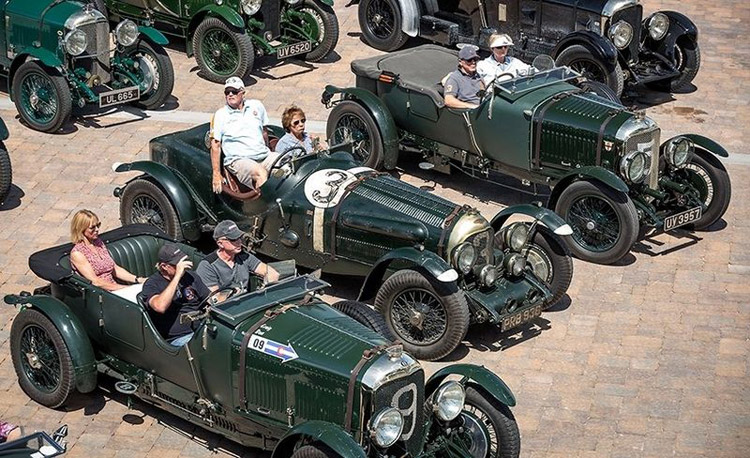Driving This Bentley Is the Closest I've Been To Being in a Wingless Biplane
Vintage Bentleys take every last ounce of concentration to drive
By Aaron Robinson - Car & Driver, Aug 2017
Walter Owen Bentley — he preferred W.O. because he never liked the name Walter — was born in 1888, the year that Jack the Ripper rose to gory fame. Bentley’s family had done well in “the trades,” as the landed gentry around Mayfair would have sniffed, and W.O. became an engineer in love with all things self-propelled. He worked on railroads and rode 3-hp motorcycles, and in 1912 became the U.K. dealer for Doriot, Flandrin, et Parant, a soon-to-be-dead French car that had electric start, hot stuff in the day.
After spending the Great War designing aircraft engines, he founded Bentley Motors in a nation racked by shortages and with much of its youthful manhood lying in shallow graves in the Somme. “To design and build a new motor car in 1919 without substantial capital,” he said later, “was like being cast on to a desert island with a penknife and orders to build a house.” Indeed, the ride lasted just 12 years, until W.O.’s archnemesis, Rolls-Royce, swooped in to snatch up the insolvent company.
It’s that early, rollicking period of independence—so richly punctuated by the colossal green carriages that Ettore Bugatti dismissed as “fast trucks,” by the fabled exploits of Captain Woolf Barnato and his Bentley Boys, by the Brooklands “Double Twelve” meet and the new 24-hour endurance contest at Le Mans that the fast trucks would win five times — that my pal Craig Ekberg wanted to celebrate when he and some friends launched the substantial task of organizing an 800-mile, five-day tour of inland California.
The tour was exclusively for “W.O.s,” as the 3034 cars from the original Cricklewood factory are called, and it was not your typical club rally. Of the 20 cars entered, the newest one was 86 years old, and they ranged in value from around $1.2 million to about $2.5 million. With an owner demographic accustomed to a certain style of travel, Craig and his cohorts planned a five-star movable pageant with epicurean accommodations and lavish smorgasbords, topping it off with a private air show on the final day. Contemporary, VW-owned Bentley even supplied some new Bentaygas.

I went to Palm Springs, east of L.A., to join up for the last two days. There had been early casualties—a holed radiator, a leaky water jacket—and heroic repair efforts made, W.O. owners apparently willing to do (or have their guy do) just about anything to keep their rigs rolling. Through the vigorous conniving that is sometimes necessary in this job, I worked myself behind the wheel of a 1931 4-liter roadster fitted with an 8.0-liter engine and belonging to Kurt Furger, a jovial Swiss pharma exec now retired to Colorado.
People used to ask me why I owned a World War II Dodge ambulance. Now I can say that it was to prepare me to drive Furger’s Bentley. After advancing the throttle and retarding the spark with steering-wheel levers to get the six inline coffee cans moving, you strain to twist the satellite dish of a steering wheel in the general desired direction and you hope for the best. The four-speed crash-box with its short, stout shifter hard against your right calf wants a swift but also a sympathetic movement that can sense whether the dog clutches might clash or bite cleanly. You always leave miles of trailing distance, your right hand ready to spring for the outside handbrake that assists the pedal brake. Yank it with a firm pull, as it supplies most of the frighteningly modest braking ability at your command. A W.O. driver cannot afford to be surprised by anything.
Driving Furger’s Bentley is the closest thing I’ve encountered to being in a wingless biplane, the wind coursing around the small Brooklands windscreens and flattening your face as the 8.0-liter blats along at its comfortable 2000-rpm cruising speed. People love these cars because they take every last ounce of concentration to drive; feel like Blenheim Palace on wheels; and transform you into old Barnato humping it for London, trying to beat the Blue Train back from Cannes to win a bet.
One Keston Pelmore, gentleman, started the Bentley Drivers’ Club and wrote of the first meeting in 1936, “On the date concerned there was excellent attendance of no less than twenty-six people.” You can’t make this stuff up, which is precisely the point: We can argue about whether money buys happiness, but no amount of gold buys a history. If Hyundai-Kia and all the Chinese newcomers could buy a century of heritage with which to market their cars, they would cut a blank check. But thanks to W.O. and Woolf and the Bentley Boys, both the originals and the ones flogging their ancient cars in the desert, it’s baked into every one of those winged Bs.
